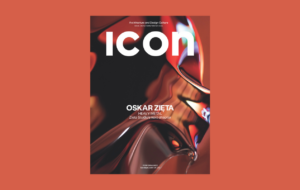In this conversation, based on a live event at Sir John Soane’s Museum in London, furniture designer Martino Gamper talks to design critic Alice Rawsthorn about his creative practice, which spans a variety of projects: exhibition design, interiors, commissions and designing mass-produced products for major furniture brands.

Gamper started out as an apprentice to a furniture maker in Merano, northern Italy, and went on to study sculpture under Michelangelo Pistoletto at the Academy of Fine Arts Vienna. He took his MA in 2000 from the Royal College of Art, where he studied under Ron Arad, and has since presented his works internationally at venues such as the Serpentine Sackler Gallery and the V&A in London, the Palais de Tokyo and Glasgow’s Modern Institute.
Rawsthorn is the author of two critically acclaimed books, Design as an Attitude (Icon 181) and Hello World: Where Design Meets Life. Her weekly design column for the New York Times was syndicated worldwide for over a decade. A regular speaker on design at events such as TED and the World Economic Forum in Davos, Rawsthorn holds an OBE for services to design and the arts.
Alice Rawsthorn: You began working with wood and wanted to become a craftsperson. Why did that command your attention initially and how did you then evolve towards design?
Martino Gamper: It was made clear to me that I shouldn’t continue further studies at high school level, and I was made redundant. Well, not quite as bad as that.
AR: But you were edging towards the precipice.
MG: I found it quite difficult to concentrate at school, so I decided I wanted to do an apprenticeship. The programme still exists where you work with a master craftsman, but once a week you go to vocational school so it means you’re not completely dropping out of school. You have an education and after five years you do an exam, which allows you to go and study; not everywhere but in certain art schools. You can go to university, basically.
AR: Making is now a huge phenomenon: making, fixing, repairing and using craft and artisanal techniques. But during this period, which was over 20 years ago, it was very unusual for designers to make their work themselves. It was literally the making of your career that you could make exactly what you wanted to, rather than waiting for a manufacturer to agree to produce it. Your ability to make your own work gave you a capacity for expressiveness and freedom that would have been denied you otherwise, but it was an unusual path at the time.
MG: Yes, the late 1990s, especially in the design and furniture world, was all about working for the right companies and, if you hadn’t worked with Cappellini at the time, you were a loser. It took a while, but I was lucky that I was in the company of the right people who also wanted to make, and early on had the right clients, who wanted me to create work for them. It was a humble beginning, when you made a simple shelf for someone. I got a lot of satisfaction from making even a one-off piece for a client, hopefully a satisfied customer.
AR: Did you have a sense of how your career was going to develop at that time, or were you making it up as you went along?
MG: Post the Milan experience, working for Matteo Thun [& Partners], I wanted to work not for industry, but only for a few specific industries. Matteo Thun’s studio designs everything from toilet seats to roof tiles and it was quite frustrating sometimes, because 60 per cent of the work we did was for nothing – it never went into production. Maybe 70 per cent. Also, once I left the RCA I realised I wanted to make a few things that would probably be kept in the world, rather than many objects that would disappear. But the rest of it was pretty much making it up as I went along. In 2000 at the RCA there wasn’t a sense of what we now know as a [design] gallery world. I started working with my gallery in Milan [Nina Yashar’s Nilufar Gallery] in 2007, but before that Nina worked mostly with vintage design. There were a couple of people in London and France working with contemporary designers, but there wasn’t really a market.
AR: There wasn’t a market, but there was an incredible community of designers, makers, writers, musicians and artists who were young, ambitious, dynamic and experimental in London, and you were very much at the heart of it. I remember meeting you at the time and you always had an obsessive idea or enthusiasm. You also staged incredible experimental food events where you’d make everything: the food, the things you’d eat the food off, the tools you’d use to cook it. Performative approaches to food are relatively common now, but they weren’t then.
MG: Yes and it was always done in collaboration with other people. The food event Trattoria al Cappello was done with three friends of mine, Maki Suzuki, Kajsa Stahl and Alex Rich, actually not far from here in Hatton Garden at a place called Hat On Wall Bar. And it also came out of necessity somehow because there was good food in London but it wasn’t as diverse as now. We were just out of college and obviously couldn’t afford to go fine dining every other day, but we wanted to have nice food. We wanted to have something that was interesting and experimental as well. And there was the social interaction that I missed, coming from Italy where you would go to a trattoria and talk with the owner, the people, the guests. Also we realised that we could earn money, then go to a restaurant and spend it, or we could spend the same amount of time doing this event, eat as well quite nicely, experiment along the way, create some objects and meet some new people.
AR: Your breakthrough after all these years of fun and experimentation was 100 Chairs in 100 Days, which is still one of your most famous projects. It involved trawling around London to find abandoned chairs that you could remake into other forms of seating. Did you plan it like that? Did you think it was time to do something ambitious and coherent, or was it something that had been percolating for a long time?
MG: It started as a collaboration with a friend of mine [Rainer Spehl] with whom I lived, worked and also studied at the RCA. We were invited to take part in the V&A Village Fete, an event that was held every summer until around 2010. Designers could have a stall and make something and sell it. It was very ad hoc and improvised. We turned up with scrap wood and put it against a wall and we would make a piece of furniture for people with the tools we had there. We called it Furniture While You Wait.
Out of this, I was asked to do an exhibition with a friend of mine who started a reclamation yard in Kensal Rise [Retrouvius]; a really interesting place to go and see furniture. We didn’t need any paper or drawing and we didn’t need to convince anyone of the idea, we did it alone and improvised. After that, Janice Blackburn, a curator, collector and patron of the arts and design, invited us to do a show at Sotheby’s called Waste to Taste, using raw material and found objects. Then me and [Mark Lee and Maki Suzuki of Åbäke] worked on a book and he said, ‘Since you want to do this project, let’s call it 100 Chairs in 100 Days’.
AR: Another thing that makes your practice relatively unusual for a designer is the nimbleness with which you’ve forged a strong rapport with the art world. One project where this was very evident was one of your exhibitions at the Serpentine Gallery in 2014. Can you talk about that?
MG: Yes, I got asked by the Serpentine Gallery to act as a curator, and design a show about it. So, design an exhibition with design. I struggled with the idea that a lot of design museums show selections of ‘the best of’: the best of chairs, the best of tables, the best of mobile phones, the best of … This never really interested me. The world is a much bigger place.
So I wanted to, first of all, mix contemporary and historic pieces. It helped that Nina [Yashar] had an amazing collection of shelves. So I put together an exhibition about shelves that talked about the last 80 years, 90 years of design, from the 1920s to 2014 [titled Design is a State of Mind]. I asked people I knew, or wanted to get to know, to lend me their collection and it wasn’t necessarily a collection, more like pieces that surrounded them and inspired them.
AR: You did another project for the Serpentine as its annual contribution to Milan Design Week at La Rinascente, the department store on Piazza del Duomo. This is one of my favourites of all your projects: In a State of Repair, for which you invited repairers, makers, craftspeople, bookbinders, 3D printers and cobblers from all over Milan to ply their trades there, and people were fascinated.
MG: The project was about a certain state and how better to manifest it than with a state of repair. I put on the building a big neon light that said In a State of Repair. I was quite surprised they did it because it’s quite a negative thing for a department store to have a big neon sign on basically saying they’re broken. But they agreed to that and we had 12 different craftspeople who would repair objects for free. So you could bring your shoes, your bag, your coat, your jumper, your bicycle, your toys and the artisans would repair them during the opening hours of the shop.
AR: Do you think it would be more or less difficult for a designer to develop the same kind of practice if they were starting now than it was for you 20 years ago?
MG: I always thought I was five years too late, wherever I went. I went to Vienna and I thought there was a certain kind of buzz but I was too late. I went to Milan. I thought I was five years too late because in the late 1990s, Milan was somehow on its way out.
AR: At least you arrived here before Brexit.
MG: Yeah. I came to London and I thought it was already quite tight. That generation of Michael Marriott, Jasper Morrison and Konstantin Grcic – I missed that train. But then what was different was it took me seven years from graduation to my first show. And for me they were the most interesting, exciting years.
Brexit is looming but I think every generation, every decade, has got its own challenge. I think it’s still exciting to see young people doing their own work. I think there’s always a question; why should there be another chair, another object? There’s so much out there.
What I discovered is maybe we have to think differently. It’s not just about creating something, reinventing the wheel, and creating something that extends up as a new utopia in a way. Maybe it’s about working more with what is there, with contemporary objects and with history, and mixing as well. A new form
of postmodernism?
















